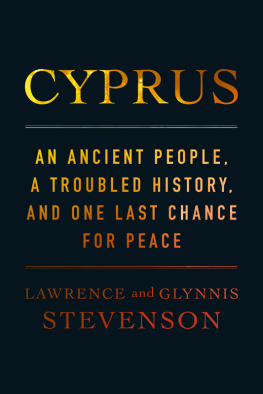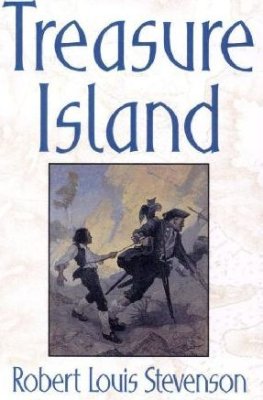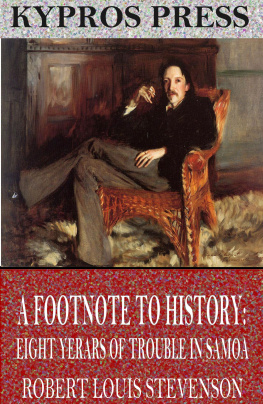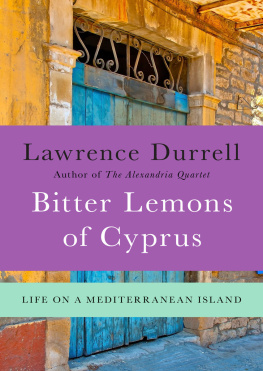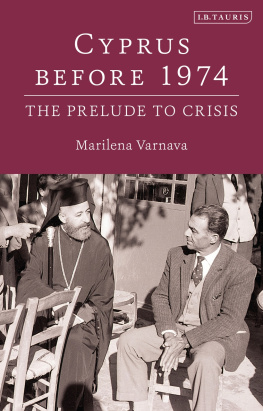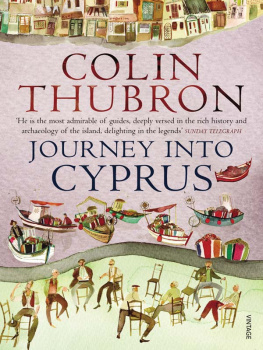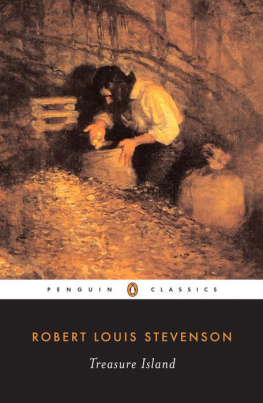CYPRUS
CYPRUS
An Ancient People,
a Troubled History, and
One Last Chance for Peace
LAWRENCE STEVENSON &
GLYNNIS STEVENSON

Sutherland House
416 Moore Ave., Suite 205
Toronto, ON M4G 1C9
Copyright 2022 by Lawrence Stevenson & Glynnis Stevenson
All rights reserved, including the right to reproduce this book or
portions thereof in any form whatsoever. For information on rights and
permissions or to request a special discount for bulk purchases, please
contact Sutherland House at
Sutherland House and logo are registered
trademarks of The Sutherland House Inc.
First edition, May 2022
If you are interested in inviting one of our authors to a live event or
media appearance, please contact
and visit our website at sutherlandhousebooks.com for more
information about our authors and their schedules.
Manufactured in Canada
Cover designed by Lena Yang
Book composed by Karl Hunt
Library and Archives Canada Cataloguing in Publication
Title: Cyprus : an ancient people, a troubled history, and one last chance for peace / Lawrence & Glynnis Stevenson.
Names: Stevenson, Lawrence, author. | Stevenson, Glynnis, author.
Description: Includes bibliographical references.
Identifiers: Canadiana 20210388366 | ISBN 9781989555637 (hardcover)
Subjects: LCSH: CyprusHistoryCyprus Crisis, 1974
Classification: LCC DS54.9 .S74 2022 | DDC 956.9304dc23
ISBN 978-1-989555-76-7
INTRODUCTION
C YPRUS ENTERED MY LIFE in 1979, when as a young officer my battalion of the Princess Patricias Canadian Light Infantry (PPCLI) was notified that we would be posted to Cyprus in 1980 for a six-month peacekeeping tour. Over several months, the battalion trained, was briefed, and read to ensure that we understood the situation in Cyprus. Hellenic culture has always been fascinating to me. In high school and college, I read and admired Thucydides, Homer, Byron, and studied the life of one of the all-time great politicians, Pericles. I was fascinated by the exploits of Alexander the Great and read about the Spartans, the Peloponnesian Wars and Thermopylae. The Turkish world was much less known to me. They were foreign and other to me based on limited knowledge that I had gleaned from my favourite film Lawrence of Arabia and from one of the popular films of that time, Midnight Express. The latter chronicled the harrowing story of an American arrested in Turkey for drug possession. Any Westerner who saw or watched Midnight Express certainly was fearful of the Turks who were portrayed in the film, as cold and brutal.
The fascination with Greek culture and wariness about Turks led most of us to head to Cyprus with a bias in favour of the Greek-Cypriots. This bias was only amplified by the reading I did as I prepared for my peacekeeping tour. Most articles and books highlighted that the problem was caused essentially by the intransigence of the Turks and the Turkish-Cypriots and that most of the mess was caused by Turkeys unprovoked invasion of Cyprus in 1974. However, the 1974 invasion was anything other than unprovoked. The actions taken by the Greeks and the Greek-Cypriots in that fateful year led directly to the Turkish invasion. Contrary to the Greek-Cypriot storyline, the Turkish invasion in 1974 was not the beginning of this sorry tale.
The Greek-Cypriots would claim that the Turkish-Cypriots have no rights to the island but this ignores the fact that the Turks have been on the island for more than 400 years and that for three centuries they were masters of the islandthe Ottoman Empire ruled Cyprus until the end of the nineteenth-century, despite being outnumbered by Greek-Cypriots. The Turks relinquished control of Cyprus to Britain in 1878 and over time the Turkish-Cypriots were increasingly marginalized and targeted by the majority Greek-Cypriots. British rule kept things in check but Cypriot independence in 1960 re-opened old wounds as both communities felt that the new constitution did not give them the powers they deserved. Greek-Cypriots would not abide by the minority rights that had been granted the Turkish-Cypriots, and in 1964 the Cypriot president, Archbishop Makarios, unilaterally abolished many of those enshrined rights which led to intensified inter-communal fighting. These escalated tensions eventually led to the introduction of UN peacekeeping forces in 1964, which kept the lid on the boiler until 1974. That year, the Greek military junta in Athens overthrew the Cypriot government with the objective of completely subjugating the Turkish-Cypriot minority and having Cyprus united with Greece, which was the ultimate dream of most Greek-Cypriots at the time.
A Greek-Cypriot coup overthrew President Makarios and put a murderous thug, Nicos Sampson, in charge of Cyprus. His stated objective was to rid the island of Turkish-Cypriots. The genocide he launched claimed many Turkish-Cypriot lives in the summer of 1974. In many villages the Turkish-Cypriot males were rounded up and never seen again. In one community, fourteen Turkish-Cypriot children were slaughtered, the youngest only four months old. These atrocities led directly to the Turkish armys intervention in the summer of 1974. This intervention by Turkey was specifically allowed, as they were a guarantor power in the 1960 Treaty that granted independence to Cyprus.
The Turkish invasion of 1974 certainly led to the division of the island that persists to this day, but it did not cause the Cyprus problem. As a young officer, my reading eventually led me to the conclusion that there was another side to this story overlooked by most Western observers. The Western bias was not helped by the fact that, as a UN peacekeeper, I socialized almost exclusively with Greek-Cypriots and seldom with Turkish-Cypriots. This was true of all the UN peacekeepers, who essentially lived their lives in Greek Cyprus with occasional forays to the Turkish-Cypriot side for either official business, quick tourist trips, or in my case for scuba diving excursions on the beautiful northern coast. We played soccer against the Greek-Cypriots and enjoyed their many fine restaurants in Nicosia. We Canadians lived in the Ledra Palace Hotel which at one time was the envy of the Levant. In 1980, it was no longer a gem, but it did offer us a swimming pool and tennis courts and a view of both sides of the protected green line in Nicosia. Our cook in the officers mess was a wonderful Greek-Cypriot and we all were invited to his daughters wedding which was a glorious affair spreading across many blocks of streets in Nicosia.
In contrast, our interactions with the Turks and Turkish-Cypriots were always more difficult and distant. Our meetings were formal and usually my discussions with Turkish-Cypriots were to tell them they could not do certain things. Watching a 1989 BBC documentary narrated by Christopher Hitchens reminded us of peacekeeping interactions with the Turks in Cyprus. In the documentary a Canadian captain, Bob Smallwood, is asking the Turks to not add sandbags to their portion of the demilitarized zone. I had told the Turkish officers the same thing nine years earlier. The Turkish army that manned the outposts on their side of the green line always viewed us suspiciously. They did not view us as an impartial and neutral force. Over time, I began to feel that the UN peacekeepers were really the Greek-Cypriot protection force. We were there to make sure that the Turks did not attack and take over the entire island given that they had been the aggressors only six years prior to our tour. I went back to Cyprus on a second peacekeeping tour in 1981 and found myself perplexed by the frustrating role of the UN. I believed then, and believe to this day, that the Turks would have taken the whole island if they had wanted to in 1974 or when I was there in 1980 and 1981. But they did not want the entire island, as that would have caused them enormous problems internationally and would have exacerbated an already serious refugee problem.

